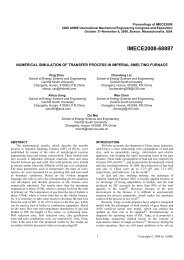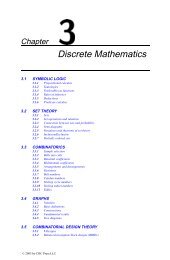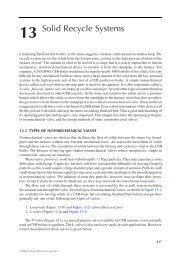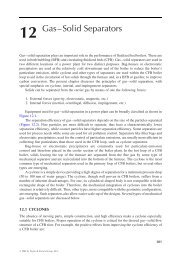Chapter 4: Geometry
Chapter 4: Geometry
Chapter 4: Geometry
You also want an ePaper? Increase the reach of your titles
YUMPU automatically turns print PDFs into web optimized ePapers that Google loves.
4.19.2.10 Summary of solution of oblique spherical triangles<br />
Given Solution Check<br />
Three sides Half-angle formulae Law of sines<br />
Three angles Half-side formulae Law of sines<br />
Two sides and<br />
included angle<br />
Two angles and<br />
included side<br />
Two sides and<br />
an opposite<br />
angle<br />
Two angles and<br />
an opposite side<br />
Napier’s analogies (to find sum and difference<br />
of unknown angles); then law of sines (to find<br />
remaining side).<br />
Napier’s analogies (to find sum and difference<br />
of unknown sides); then law of sines (to find<br />
remaining angle).<br />
Law of sines (to find an angle); then Napier’s<br />
analogies (to find remaining angle and side).<br />
Note the number of solutions.<br />
Law of sines (to find a side); then Napier’s<br />
analogies (to find remaining side and angle).<br />
Note the number of solutions.<br />
4.19.2.11 Haversine formulae<br />
Ú ½ Ó× <br />
×Ò ¾<br />
¾<br />
¾<br />
Ú´ µ · ×Ò ×Ò Ú <br />
×Ò´× µ ×Ò´× µ<br />
Ú <br />
×Ò ×Ò <br />
Ú Ú´ µ<br />
<br />
×Ò ×Ò <br />
Ú½¼ Æ ´ · µ℄· ×Ò ×Ò Ú <br />
Gauss’s<br />
formulae<br />
Gauss’s<br />
formulae<br />
Gauss’s<br />
formulae<br />
Gauss’s<br />
formulae<br />
4.19.2.12 Finding the distance between two points on the earth<br />
To find the distance between two points on the surface of a spherical earth, let point<br />
È ½ have a (latitude, longitude) of ´ ½ ½ µ and point È ¾ have a (latitude, longitude)<br />
of ´ ¾ ¾ µ. Two different computational methods are as follows:<br />
1. Let be the North pole and let and be the points È ½ and È ¾ . Then the<br />
spherical law of cosines for sides gives the central angle, , subtended by the<br />
desired distance:<br />
Ó×´µ Ó×´µÓ×´µ · ×Ò´µ×Ò´µ Ó×´µ<br />
where the angle is the difference in longitudes, and and are the angles of<br />
the points from the pole (i.e., ¼ Æ latitude). Scale by ʨ (the radius of the<br />
earth) to get the desired distance.<br />
2. In ´Ü Ý Þµ space (with ·Þ being the North pole) points È ½ and È ¾ are represented<br />
as vectors from the center of the earth in spherical coordinates:<br />
¢ £<br />
v ½ ¢ ʨ Ó×´ ½ µÓ×´ ½ µ ʨ Ó×´ ½ µ×Ò´ ½ µ ʨ ×Ò´ ½ µ £ <br />
v ¾ ʨ Ó×´ ¾ µÓ×´ ¾ µ ʨ Ó×´ ¾ µ×Ò´ ¾ µ ʨ ×Ò´ ¾ µ <br />
(4.19.3)<br />
© 2003 by CRC Press LLC










